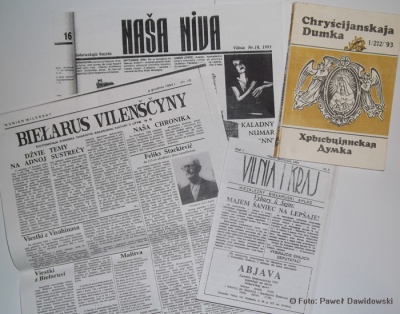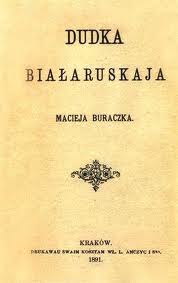Clash of Civilizations: Latin v Cyrillic Scripts in Belarus

In November 2012, the newly published Minsk underground system map surprised Minsk residents.
On these maps, Belarusian names of the stations were transliterated into Belarusian using Latin script, or Lacinka. This transliteration seemed incomprehensible to many people and caused a big discussion in media.
For most Belarusians today, Latin script became an attribute of western world. Few of them know that only a century ago it was commonly used along with Cyrillic letters. Yet another group of their more informed country fellows are familiar with Belarusian Lacinka and try to defend its presence in public areas.
In the case of the underground map, one side advocated the comprehensibility of transliteration, while the other defended original national script regardless its practical aspect. While the opponents of Lacinka accuse its advocates of excessive nationalism and impracticability, the advocates argued that the opponents do not know national history and have a complex of superiority of foreigners.
The Minsk Underground Map
Belarus is hosting world hockey championship in 2014. Belarus authorities attempt to make the environment of Belarus cities more friendly to foreign visitors. This is why they introduced Latin letters on the underground map.
The way the station names were transliterated drew a lot of public attention. Instead of usual transliteration system similar to Russian, authorities decided to use Belarusian Lacinka. The reason for such move remains not clear, but nationally oriented part of the society met this phenomenon with rejoicing, while the rest were quite surprised, and some even angry.
Within a few days, a video appeared on the web, where a foreigner tries to read the names and fails to do so. This fact became the main argument of the opponents of Belarusian Lacinka: it is unintelligible for foreigners.
Their opponents see the problem from the other angle. More “English” type of transliteration can be used when a country has no tradition of Latin script of its own. Belarus had one for centuries, so it can be reasonably used in transliteration of Belarusian language.
They point to the languages of other East European nations, like Czechs, Slovenians, Lithuanians and Latvians, who have similar systems of script with diacritical signs, but do not bother whether a visitor from another country will be able to read their words properly. Therefore, the defenders of English-friendly transliteration seem to have a complex of superiority of the English civilization.
The History of Latin Script in Belarus
Belarus is located on the borderland of two major civilizations, the East and the West, Catholic and Orthodox, no wonder both Cyrillic and Latin scripts developed here abreast since Middle Ages.
In the Grand Duchy of Lithuania, the predecessor of modern Belarus, Latin script was used for recording Latin and Polish languages. From the 16th century on, Latin script started to be used for recording Old Belarusian language as well.
Lacinka became the script of the first literary works in Belarusian languages that appeared in 19th century, when a few intellectuals and writers started to promote Belarusain, which was then mostly the language of peasants. Russian Empire rulers considered Latin Script as a threat that could separate “ethnographic groups” such as Belarusians and Ukrainians from the single Russian nation. They formally banned Lacinka, yet Belarusian intellectuals continued to use it in their works.


After a number of transformations and reforms, Belarusian Lacinka separated from the Polish alphabet. Diacritical signs stemming from Czech alphabet replaced Polish characters to defend Belarus from Polish influence (for instance, č, š, ž replaced cz,sz, ż). Lithuanians made similar steps, as their writing had also been based on the Polish alphabet.
Belarusians equally used Lacinka and Cyrillic script until the partition of Eastern and Western Belarus between Poland and USSR in 1921. Soviet authorities discouraged the use of Lacinka and soon it disappeared in soviet part of Belarus. In Poland, it continued to exist until USSR annexed Western Belarus after World War II.
The Renaissance of Lacinka
The interest in Lacinka reemerged after the collapse of USSR and return to national culture and policy of Belarusianisation. Not surprisingly, Lacinka failed to win immediate mass support – people were simply used to the Cyrillic script. Even among nationally oriented intellectuals, there always were both advocates and opponents of return of Latin script in mass use.
However, Belarusian Lacinka became not only the passion of a bunch of enthusiasts. In 2000, Institute of Language of National Academy of Sciences established it as a base for transliteration of Belarusian proper names in foreign languages.
Hence, it was reasonable to expect that Lacinka would be widely used in state institutions for transliteration matters. However, it did not happen. Belarus authorities continued to transliterate most common case for transliteration, names in the passport and geographical names, following the system used in Russia, rather than the trditional Belarusian Lacinka.
In online English-language resources, there is no uniform pattern of transliteration. Google Maps, for instance, uses a bizarre mixture of various systems of transliteration in naming Belarusian geographical objects. Sometimes names appear in Belarusian cyrillic, sometimes in Lacinka, sometimes in Russian and not always correctly.
Because of poor use of Lacinka in public matters, it remains unknown to most Belarusians. This lack of knowledge creates the ground for discussions such as the one related to the underground map.
The Future of Latin Script in Belarus
State policy up to now did not favour Belarusian language in general, let alone its Latin script. Lacinka became a symbol of western civilization that Lukashenka and his entourage consider alien. Many Belarusians remain unaware of many facts of their history and culture prior to World War II, the core element of official ideology. But as discussions like the one on tube scheme go on, more and more Belarusians get to know that they have richer legacy than they could imagine.
Nevertheless, the future of Lacinka remain undefined. Some people advocate its introduction into wider use. They say that Latin script will bring Belarus closer to the West and push Russia away. Others argue that initially people should preserve Belarusian language itself which stands on the verge of extinction, and only thereafter engage in disputes over scripts and other minor details. For some, it remains a matter of pride in glorious past, for others – just a ridiculous thing and even nonsense.
So, the attitude to Lacinka remains the ground for cleavage in Belarus. But Belarusians badly need symbols of unity that can hold their fragile national identity together, rather than differences. This presents a task, which future nation-builders of Belarus will have to face and resolve.
Vadzim Smok




